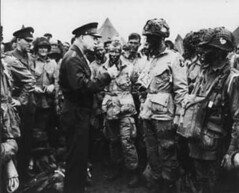
"You will bring about the destruction of the German war machine, the elimination of Nazi tyranny over the oppressed peoples of Europe, and security for ourselves in a free world. Your task will not be an easy one. Your enemy is well trained, well equipped, and battle-hardened. He will fight savagely. . . The free men of the world are marching together to victory. I have full confidence in your courage, devotion to duty, and skill in battle. We will accept nothing less than full victory. Good luck, and let us all beseech the blessings of Almighty God upon this great and noble undertaking."
- General Dwight D. Eisenhower giving the D-Day order on June 6, 1944.
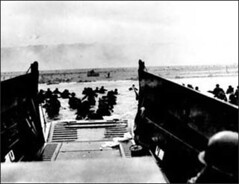
Assault landing. One of the first waves at Omaha. The Coast Guard caption identifies the unit as Company E, 16th Infantry, 1st Infantry Division.
"There was another guy beside me and we were the first two off that boat. I went immediately into the water. It was shallow enough that I was able to get up. There was nothing. No bodies - because we were the bodies." - Michael Accordino, who landed in the first wave on Omaha with Company A of U.S. Army's 299th Engineer Combat Battalion.
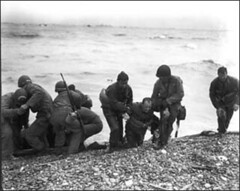
Members of an American landing party lend helping hands to other members of their organization whose landing craft was sunk be enemy action of the coast of France. These survivors reached Omaha Beach by using a life raft.
Over 160,000 Allied troops and 30,000 vehicles are landed along a 50-mile stretch of fortified French coastline and begin fighting on the beaches of Normandy.
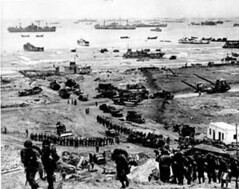
The build-up of Omaha Beach. Reinforcements of men and equipment moving inland.
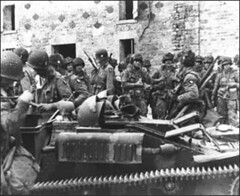
A group of paratroopers in a French village at St. Marcouf, Utah Beach, France
"The joy of liberation was extraordinary."- Lucy David-Pellerin, aged 17 when Allied troops reached Lisieux in late August 1944.
In April and May 1944, the Allied air forces lost nearly 12,000 men and over 2,000 aircraft in operations which paved the way for D-Day.
Total Allied casualties on D-Day are estimated at 10,000, including 2,500 dead. British casualties on D-Day have been estimated at approximately 2,700. The Canadians lost 946 casualties. The US forces lost 6,603 men.
Casualties on the British beaches were roughly 1,000 on Gold Beach and the same number on Sword Beach. The remainder of the British losses were amongst the airborne troops: some 600 were killed or wounded, and 600 more were missing; 100 glider pilots also became casualties. The losses of 3rd Canadian Division at Juno Beach have been given as 340 killed, 574 wounded and 47 taken prisoner.
The breakdown of US casualties was 1,465 dead, 3,184 wounded, 1,928 missing and 26 captured. Of the total US figure, 2,499 casualties were from the US airborne troops (238 of them being deaths). The casualties at Utah Beach were relatively light: 197, including 60 missing. However, the US 1st and 29th Divisions together suffered around 2,000 casualties at Omaha Beach.
The total German casualties on D-Day are not known, but are estimated as being between 4,000 and 9,000 men.
Statistics from http://www.ddaymuseum.co.uk/
View More Photos

 D-Day: June 6, 1944
D-Day: June 6, 1944













































